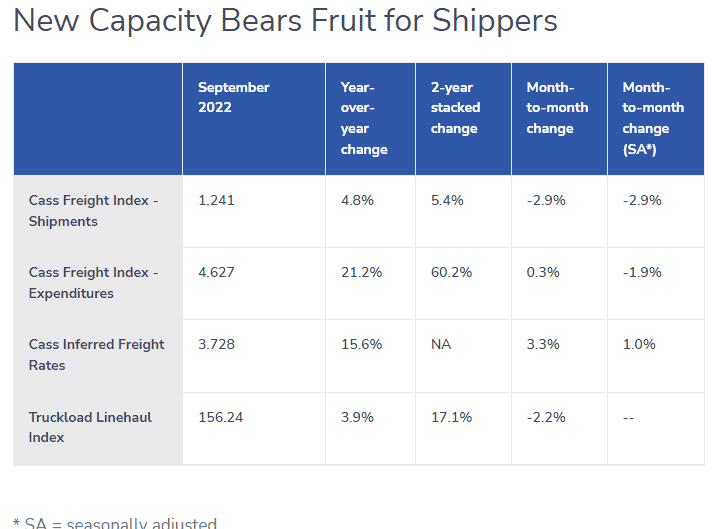In early 2022, many trucking sector analysts were predicting an imminent “freight recession." Then just recently, KeyBanc transportation sector analysts Todd Fowler and Carney Blake said a "trucking winter" was on the horizon,
as they downgraded the stocks of trucking companies such as J.B. Hunt Transportation and Schneider National. (See Trucking Winter on its Way Soon, Analysts from KeyBanc Say.)
There's is just one problem: the freight recession rather stubbornly refuses to show up.
Evidence in point: Cass Information Systems is fresh out with its freight report for September, and results were surprisingly strong given other signs of an economic slowdown.
Surpply Chain Digest Says...
|
 |
| Cass notes that it "includes both spot and contract freight, and with spot rates already down significantly, it’s only a matter of time until the index begins to decline on a year-over-year basis," |
 |
What do you say? |
| Click here to send us your comments |
 |
| Click here to see reader feedback |
|
The monthly report from Cass and partner Tim Denoyer of ACT Research is based on data from the billions of dollars of freight bills that Cass pays for its shipper clients.
The Cass Shipments Index, which includes multiple modes but is weighted towards full truckload freight, was up a solid 4.8% year-over-year in September. However, month-over-month the index was down 2.9%, after rising 5.5% in August.
Why the recent strength in freight volumes? Cass cites several factors:
• Retail discounting to clear excess inventory in some categories
• Seasonal inventory building ahead of the holidays
• Repositioning mis-timed inventory
• Easing supply constraints, particularly in auto production
• Easier prior-year comparisons
The September expenditures component of the Cass Freight Index, which measures the total amount spent on freight, was up 21% versus 2021, about the same as the year-over year gain in July. On a seasonally adusted basis, however, expenditures fell 1.9% month-over-month September, with shipments down 2.9% and rates up 1.0%.
The Cass Expenditures Index includes changes in fuel, modal mix, intramodal mix, and accessorial charges in addition to core rates changes.
(See More Below)
|
CATEGORY SPONSOR: SOFTEON |
|
|
| |
|
|
Another look at rates comes from the Cass Linehaul Index, which measures US per mile truckload rates before fuel surcharge and other
accessorials.
In September, that index was up 3.9% year-over-year, down from a 7.4%% increase in August. Month-over-month, the linehaul index fell a modest 2.2%, slightly more than the 1.8% declines seen in each of the past three months.
Relative to the index, Cass notes that it "includes both spot and contract freight, and with spot rates already down significantly, it’s only a matter of time until the index begins to decline on a year-over-year basis," which it expects will be seen in early 2023.
In additional commentary, Denoyer observes that "It sure doesn’t feel like freight volumes were up nearly 5% year-over-year in September, does it? Our analysis suggests this will not repeat for quite some time, and it took the right combination of easy comps and temporary factors to make happen."
Denoyer also raises the question of how this recent demand strength in trucking can be compatible with consistent and significant downtrends in ocean container and truckload spot rates.
"In a word, supply," he respond, adding that "In our view, it’s the cumulative massive effort of ramping up supply chain capacity over the past two years, amid varying stages of crisis, which is now bearing fruit."
Each month, Cass nicely summarizes the state of freight, as seen in the graphic below for September:

Source: Cass Information Systems
Summing the market situation up, Denoyer observes that "While demand is still looking about flat this year, the supply side recovery has turned the market from tight to loose" - which should mean lower rates for shippers soon enough.
Any thoughts on the Cass report? Let us know your at the Feedback section below.
|